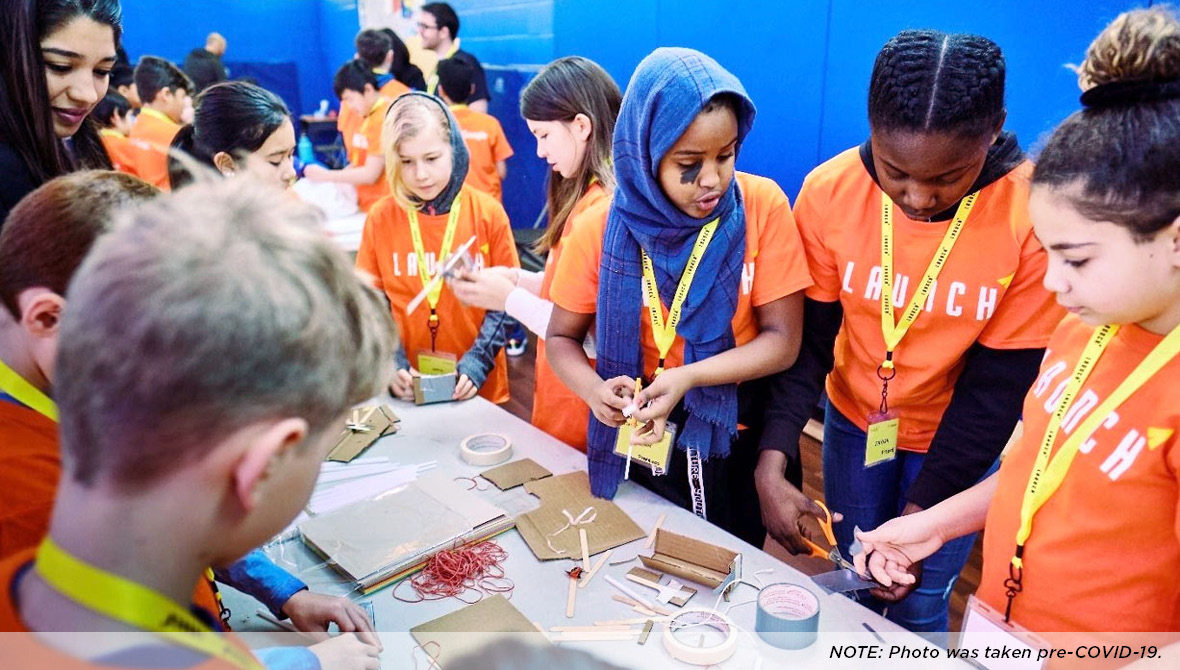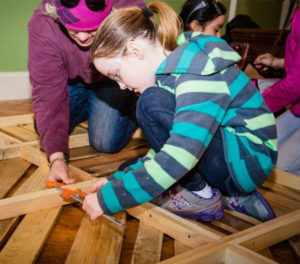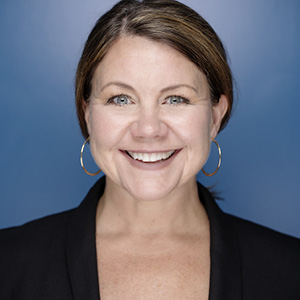Beyond Transaction and Prescription: An Inclusive Approach to Giving Nets Greater Impact


Prior to the establishment of the Bosch Community Fund in 2011, Bosch in North America maintained a corporate contributions program to support the communities where we have a presence. The Bosch Community Fund was created to expand upon these existing investments and activities to develop a unique, comprehensive approach to grantmaking and community engagement.
Today, the Bosch Community Fund has moved beyond a prescriptive and transactional model when it comes to grantmaking and relationships with grant recipients to engage an inclusive group of stakeholders that drive dialogue, discussion, and best practices to inform grant investments. We’ve established groups called Community Advisory Committees (CACs) in 45 Bosch in North America sites.
This unique approach to grantmaking was inspired by conversations with colleagues in the automotive industry. These discussions highlighted the broad idea of a different, yet inclusive, approach to grant giving that gives communities a voice regarding how funds are utilized in their areas. This concept ignited discussions within the company that ultimately led to formally create the CAC model, which was executed in line with the ethos of Bosch and its culture of inclusivity.
At the Bosch Community Fund, we focus our grantmaking on issues relating to science, technology, engineering, and math (STEM), as well as environmental conservation and education. CAC meetings focus on the opportunity to listen and learn from stakeholders about the most pressing issues within a community as they relate to these priority areas. This forms the basis for highly informed and targeted grantmaking for the Fund’s staff.

After more than eight years of building and developing this practice, this decision-making process emphasizes community engagement and feedback as the driver of the work. Based on this experience, the following outlines how other organizations can leverage this inclusive approach to their own grantmaking.
Appoint a key contact in the community. As a first step, we identify a Bosch in North America team member at each local Bosch site based on their interest in working with the Fund, their familiarity with the community, and their role within the organization (e.g., HR, communications, etc.). We narrow this list down to a “key contact” who will act as the lead liaison to the Fund staff and help identify stakeholders in the community to include in the committee. Additional stakeholders are invited to serve on the committee as it evolves. Since each of the lead liaisons has a varying level of time and resources to dedicate to this process, the Bosch Community Fund staff must adjust its support accordingly.
Gather a diverse group of community leaders. The lead Bosch liaison at each site location invites local representatives that make up the fabric of the community such as, corporate, nonprofit, academic, and government members to provide valuable insights on various perspectives and challenges. By bringing these voices together, our funding and the CAC can develop solutions, through a more balanced approach, to ultimately determine the greatest STEM education and environmental sustainability needs of the community.
Meet community members where they are — literally. Introductory meetings are hosted at the Bosch facility site to give community members an insight into Bosch’s culture. Once they are familiar with the company, meetings are typically hosted by committee members at their own office which offers participants an opportunity to share their work and introduce their broader teams with the group. This approach creates a deeper relationship and familiarity with the community and the grant applicants. Committee meetings prompt related conversations that sometimes uncover funding opportunities or challenges the greater group can support with ongoing conversations.
Lean into your role as conveners. Although typically not the largest funder in each community, the Bosch Community Fund aims to be an active partner — we’re willing to build upon existing programs, provide funding for new approaches, and help leverage other funding aid. Additionally, we actively encourage sharing of both successes and obstacles to support the increased effectiveness of future grant investments.
The impact of the model has led to the development of small philanthropic ecosystems in the Bosch site communities that rely on the engagement and input of valued nonprofit partners, educators, and community members. Members will sometimes continue to work together, post-meeting — for the purpose of further networking and/or collaborations in smaller subsets.
Inclusive and Ongoing Communications – CACs convene annually with Bosch and the Bosch Community Fund. They serve as a mechanism to support the regular and consistent flow of information between the Fund staff and each site community to inform where the greatest needs lie — within the guideposts of the Fund’s focus and priority areas. During annual meetings, the group is asked if there is anyone from community that may be missing from the group that can add value. We want to ensure the group represents the community as much as possible. Typically, 70% of the Bosch Community Fund’s annual giving is distributed through the CAC model.
Maintaining an Active and Productive Group – To ensure that members in more than forty CAC groups are working collaboratively, the Bosch Community Fund informally monitors several performance metrics. With our goal to serve the best interests of the community, which also informs our funding investments, it’s important that groups maintain a productive level of collaboration. Therefore, we regularly connect with the Bosch liaison at each of CACs to make sure there is a consistency of attendance, awareness of community issues along with sharing best practices, failures, and project successes.
From the company perspective, Jill Boileau of Climatec, a Bosch subsidiary said,
“I have been working with the Bosch Community Fund for years, and as a former educator, I can attest to how unique and effective their communication style is. For example, the group decided to give funding to a local school district to create greenhouses and associated curriculum to support hands-on learning. One year later, I toured the elementary, middle, and high schools to see the funding in action. Students gave insightful presentations of the different elements they had learned with great excitement, along with providing a tour of the impressive greenhouses. It was astounding to see how much the students learned and accomplished in one year. That experience will have a lasting impact on the student’s academic journeys.”
Bosch Community Fund staff advises committee members regarding our areas of support, as well as the Fund’s designated priority areas: teacher efficacy; project-based learning; and diversity, equity, and inclusion. Within those guideposts, and sometimes to a broader extent, we are able to encourage honest and rich discussions about community issues, best practices, methods that have worked, and those that have not been successful.
Courtney Wright from the Tri-County Technical College Foundation shares her experience:
“The Fund wants to know if a program hasn’t worked out as planned. They are willing to collaborate with you to enhance the program and its impact. They function as a local partner that cares about outcomes versus a large corporation that just gives funding and then you may not hear from them again.”
Based on feedback we’ve received over the years, this model allows the opportunity to share ideas and best practices, troubleshoot issues, and form collaborations that sometimes may not pertain to a Bosch grant but ultimately help a community in other ways.
For instance, Dawn Magretta, Executive Director of the Schoolcraft College Foundation and Bosch Community Fund grantee said, “Since I’ve experienced how well this grantmaking model has worked over the years, we have implemented the same inclusive communication approach to internal decision-making that has resulted in similar positive outcomes.” She continues, “The approach is not competitive, the ultimate goal is to truly bring a community together and have the best impact possible. Every time the Bosch Community Fund convenes, we create lasting impact that really benefits the community.”
Of note, the Bosch Community Fund operates on an “invitation-only basis.” Therefore, participation in community advisory committee meetings is not necessarily a guarantee of an invitation to apply. On the flipside, members can be on the CAC and not seek funding yet still offer a great deal of insight into key issues and support the overall discussion of community needs. More so, the CAC model is meant to be flexible, it evolves with community and over time with the addition of new members that provide their valuable perspectives.


Feedback from higher education partners and related research revealed that students pursuing STEM college degrees who do not have strong math skills, which is nearly required for most STEM careers, may lose interest in obtaining a job in this area compared to more math-proficient peers (Park, Ngo, & Melguizo, 2019).
Through the CAC model, we have an impact on issues in several ways such as, increased student aptitude, interest, awareness, access, and retention in STEM and environmental sustainable education. Additionally, we are committed to have administrators and teachers to learn content and integrate it into the curriculum. Through funding, they gain greater access to STEM resources such as, professional development training and equipment to create exceptional and innovative learning experiences.
Throughout CAC discussions, the Fund staff put an emphasis on the willingness and importance of supporting basic K-12 math programs for all students. In addition, through higher education partnerships, the Fund has made investments in programs that support necessary foundational math skills for secondary education students interested in STEM college degrees.
We continuously pursue and share feedback amongst ourselves, our corporate colleagues, and the community leaders who make up our CACs. This process underscores how the dissemination of successful programming through the CAC model can support the overall STEM ecosystem.
Through stakeholder feedback, the Fund staff learned that grant application processes can be a deterrent for some schools and nonprofits which may not have the necessary skills or resources to complete a lengthy grant proposal and/or grant report. It’s important to work with current or potential grantees that may be unfamiliar with the different elements of applying for a grant. The Bosch Community Fund staff acts a resource to help with the application and reporting process whether it’s explaining what financial statements are required or outlining specific intended impacts.
Through a development process with the Johnson Center for Philanthropy, we identified key performance indicators that are essential to track for the purpose of gauging the outcomes of a grant and effectively reporting those results back to stakeholders, including the Bosch Community Fund board of trustees and community advisory committees. Jill Boileau of Climatec adds, “Typically, grant processes can be very tedious, but the Bosch Community Fund’s approach is streamlined start to finish so there aren’t any barriers to apply or report about a grant.”
Obtaining metrics at the community and national level is a critical piece to informing future funding support. Each grant applicant identifies the metrics it intends to influence through its work from criteria that is provided by the Fund. Since applicants were invited to apply based on their work and the Fund’s familiarity with them through the community advisory committee, they are likely to share and be aligned to these intended outcomes. The reporting system aggregates data on an individual grantee along with providing regional insights and highlights trends on a national level. This method allows the Fund to report insights, results, or trends internally to its board and to community partners. The data is also shared with site communities, offering partners the opportunity to better understand which programs made the greatest impact both within their own communities, in other locations and nationally as well.
The Bosch Community Fund will continue to utilize the Community Advisory Committee model as a tool to support effective grantmaking and strong community engagement. The intent will be to continue to build upon the model while also finding new ways to support the connection of those within communities, as well as within other Bosch site communities to improve outcomes for students.

Park, E., Ngo, F., & Melguizo, T. (2019, December). Starting off on the wrong foot [Research brief]. Wheelhouse, The Center for Community College Leadership and Research, 4(3). https://education.ucdavis.edu/sites/main/files/ucdavis_wheelhouse_research_brief_vol4no3_online_0.pdf